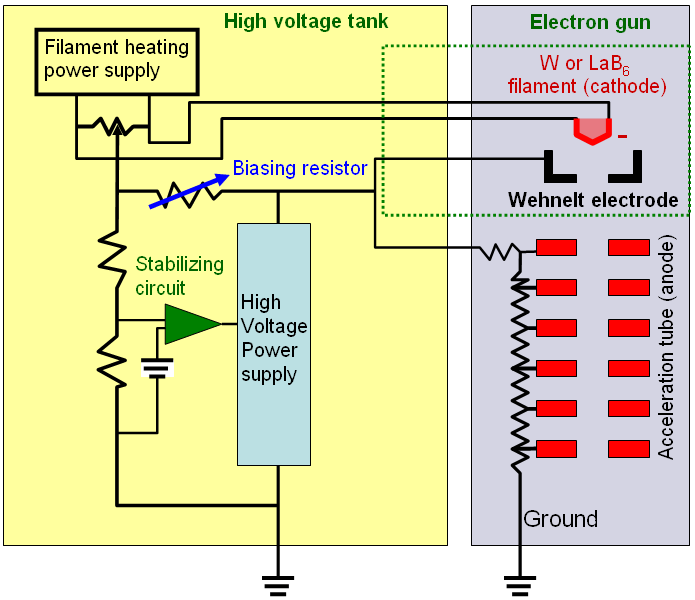Thermionic Electron Emission Guns - Practical Electron Microscopy and Database - - An Online Book - |
||||||||
| Microanalysis | EM Book http://www.globalsino.com/EM/ | ||||||||
| This book (Practical Electron Microscopy and Database) is a reference for TEM and SEM students, operators, engineers, technicians, managers, and researchers. | ||||||||
| ================================================================================= | ||||||||
The thermionic emission gun is one of the simplest and most robust electron sources. The primary components is composed of a heated filament acting as a cathode, a “grid” called the Wehnelt cylinder and an anode. In these conventional electron guns, resistance heating is produced in the gun filaments and electrons are boiled off the tip by thermionic emission when a high enough current is passed through the filament. For an emission voltage requirement of 200 kV, the emitted electrons have a negative potential of 200 kV with respect to the anode, and thus they are accelerated towards the anode and gain 200 keV of energy. The Wehnelt cylinder has a small negative bias to confine the beam and enable it to pass through the anode into the column. Thermionic electron emission guns mainly include LaB6 thermionic electron guns and tungsten thermionic electron guns. Figure 3260 shows the schematic illustration of the electric circuit of thermionic electron guns with tungsten and LaB6 filaments. The main part which is different from thermal FEG is dash-green-boxed.
Figure 3260. Schematic illustration of the electric circuit of thermionic electron guns with tungsten and LaB6 filaments.
With increase of bias voltage in thermionic emission gun, the emission current increases and the heating temperature necessary for emission saturation becomes higher. On the other hand, with increase of heating temperature, the emission current also increases, the energy spread of emitted electrons becomes wider, and the lifetime of the filament becomes shorter. A Schottky emission electron gun is based on field-assisted thermionic emission [1] and the electrons overcome the barrier lowered due to the Schottky effect without tunnelling. For TEM analysis, the size of electron source must be large to achieve a large area of illumination with sufficient electron density. From this point of view, thermionic sources are more than capable of meeting these criteria. However, this relatively large source size in addition to a large electron energy spread means that thermionic sources are not applicable to scanning probe microscopy and EELS microanalysis. For TEMs with thermionic electron sources, the MDM (minimum detectable mass) of EDS measurements is in the range of 10-19 to 10-20 g, equivalent to ~100 - ~1000 atoms thick of iron (Fe). For TEMs with FEGs (field emission guns), it is possible to detect a few atoms thick with EDS technique.
[1] Reimer L (1997) Transmission Electron Microscopy, 4th edn, p. 90. (Springer-Verlag, Berlin.)
|
||||||||
| ================================================================================= | ||||||||
| The book author (Yougui Liao) welcomes your comments, suggestions, and corrections, please click here for submission. If you let book author know once you have cited this book, the brief information of your publication will appear on the “Times Cited” page. | ||||||||
|
|
||||||||
